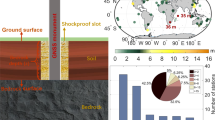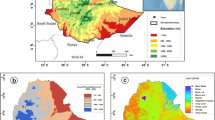Abstract
The strike-slip earthquake on 28 September 2018 (Mw 7.5) along the Palu-Koro fault on Sulawesi Island has raised concerns about the potential impact of tsunamis generated by submarine landslides in Palu Bay, Indonesia. The horizontal displacement of the Palu-Koro fault generated landslide tsunamis that covered Palu Bay, creating wave-related hazards along the coastal area. Based on the unusual amount of information on this tsunami, this study investigated possible sources using the available preliminary data. The generation of comparatively small tsunamis by coseismic seafloor deformation is omitted, and only tsunamis generated by submarine/subaerial landslides are analyzed in this study. Two-layer modeling (soil and water) based on the shallow-water equation was used to simulate the tsunami propagation in the bay with severe, moderate, and minor impacts. The accuracy of the model was validated based on the waveform at the Pantoloan tidal gauge and trace data. The tsunami heights from a combination of small to large submarine landslides could reach up to 3.0–7.0 m along the Palu shores. This model focused on studying the effects of the tidal level on coastal inundation in Palu Bay, using the 2018 Palu tsunami event as a benchmark scenario, to demonstrate the capabilities of the model. One result shows that, regardless of the tidal level, the 2018 Palu tsunami, which occurred during high tide, will always result in flooding, with a maximum tsunami height of up to 7.0 m above mean sea level. The main results suggest two causes for this tsunami event: the tsunami source and the topography. First, the model requires one large source at the bay entrance to reproduce the arrival time (approximately 5 min) and the large wave observed at the Pantoloan gauge. To reproduce the later waves, small sources in the bay (S1–S6) and minor large sources (L2 and L3) are needed. Second, the datum correction for the terrain is changed to improve the accuracy of the water level. Additionally, the removal of buildings from the topography is important to achieve highly accurate flow depths and to obtain an inundation area close to the real situation. The impacts along the coastline of Palu Bay from peak waves can be used to identify tsunami hazards in the area in the future.




















Similar content being viewed by others
References
Aida, I. (1978). Reliability of a tsunami source model derived from fault parameters. Journal of Physics of Earth, 26, 57–73.
Arikawa, T., Muhari, A., Okumura, Y., Dohi, Y., Afriyanto, B., Sujatmiko, K. A., et al. (2018). Coastal subsidence induced several tsunamis during the 2018 Sulawesi earthquake. Journal of Disaster Research, 13, 1–3.
Badan Geologi. (2018). DI BALIK PESONA PALU: Anomali Perilaku Gelombang Tsunami (pp. 133–141). Baundung Indonesia. (in Indonesia).
European Commission. (2018). Mw 7.5 earthquake in Indonesia, 28 Sep 2018, JRC Emergency Reporting—Activation #021—UPDATE #1—01 Oct 2018.
Fine, I. V., Rabinovich, A. B., Thomson, R. E., & Kulikov, E. A. (2003). Numerical modeling of tsunami generation by submarine and subaerial landslides. In A. C. Yalciner, E. N. Pelinovsky, C. E. Synolakis, & E. Okal (Eds.), Submarine landslides and tsunamis, NATO adv. series (pp. 69–88). Dordrecht: Kluwer Academic Publishers.
Fine, I. V., Rabinovich, A. B., Bornhold, B. D., Thomson, R. E., & Kulikov, E. A. (2005). The Grand Banks landslide-generated tsunami of November 18, 1929: Preliminary analysis and numerical modeling. Marine Geology, 215(1D2), 45–57.
Gomez, R., Madariaga, A., Walpersdorf, A., & Chalard, E. (2000). The 1996 earthquakes in Sulawesi, Indonesia. Bulletin of the Seismological Society of America, 90(3), 739–751.
Grilli, S. T., Harris, J. C., Tayebeh, S., Bakhsh, T., Masterlark, T. L., Kyriakopoulos, C., et al. (2012). Numerical simulation of the 2011 Tohoku tsunami based on a new transient FEM co-seismic source: Comparison to far- and near-field observations. Pure and Applied Geophysics, 170(6–8), 1333–1359.
Gylfadottir, S. S., Kim, J., Helgason, J. K., Brynjolfsson, S., Hoskuldsson, A., Johannesson, T., et al. (2017). The 2014 Lake Askja rockslide-induced tsunami: Optimization of numerical tsunami model using observed data. Journal of Geophysical Research: Oceans, 122, 4410–4422.
Heidarzadeh, M., Krastel, S., & Yalciner, A. C. (2014). The state-of-the-art numerical tools for modeling landslide tsunamis: A short review. In: Krastel S. et al. (eds), Submarine Mass Movements and Their Consequences. Advances in Natural and Technological Hazards Research, 37, Chapter 43 (pp. 483–959). USA: Springer International publishing.
Heidarzadeh, M., Muhari, A., & Wijanarto, A. B. (2018). Insights on the source of the 28 September 2018 Sulawesi tsunami, Indonesia based on spectral analysis and numerical simulations. Pure and Applied Geophysics, 176, 25–43.
Heinrich, P. H., Piatanesi, A., & Hébert, H. (2001). Numerical modelling of tsunami generation and propagation from submarine slumps: The 1998 Papua New Guinea event. Geophysical Journal International, 145, 97–111.
Iglesias, O., Lastras, G., Canals, M., Olabarrieta, M., González, M., Aniel-Quiroga, I., et al. (2012). The BIG’95 submarine landslide-generated tsunami; a numerical simulation. The Journal of Geology, 120(1), 31–48.
Imamura, F. (1995). Review of tsunami with a finite difference method. Long-wave runup models (pp. 25–42). Singapore: World Scientific Pub Co Inc.
Imamura, F., & Hashi, K. (2003). Re-examination of the source mechanism of the 1998 Papua New Guinea earthquake and tsunami. Pure and Applied Geophysics, 160, 2071–2086. https://doi.org/10.1007/s00024-003-2420-2.
Imamura, F., & Imteaz, M. A. (1995). Long waves in two-layers: Governing equations and numerical model. Science of Tsunami Hazards, 13(1), 3–24.
Imamura, F., Shuto, N., & Goto, C. (1988). Numerical simulation of the transonic propagation of tsunami. In: Proceeding of 6th Congress Asian and Pacific Reginal Division. IAHR, Japan.
Kowalik, Z., & Murty, T. S. (1993). Numerical modeling of ocean dynamics (p. 481). Singapore: World Scientific Pub.
Lastras, G., De Blasio, F. V., Canals, M., & Elverhøi, A. (2005). Conceptual and numerical modeling of the Big’95 debris flow, western Mediterranean Sea. Journal of Sedimentary Research, 75, 784–797.
Liu, P. L. F., Woo, S. B., & Cho, Y. S. (1998). Computer programe for tsunami propagation and inundation. Technical report; Cornell University: Ithaca, NY, USA.
Lutfi, M., Afifah, R. S., Sulaiman, B., & Risna, B. (2018). Numerical simulation of hydrodynamic for abrupt bathymetry in Palu river estuary. Indian Journal of Science and Technology, 11(23), 1–5.
Macías, J., Vázquez, J. T., Fernández-Salas, L. M., González-Vida, J. M., Bárcenas, P., Castro, M. J., et al. (2015). The Al-Borani submarine landslide and associated tsunami. A modelling approach. Marine Geology, 361, 79–95.
Maeda, T., Tsushima, H., & Furumara, T. (2016). An effective absorbing boundary condition for linear long-wave and linear dispersive-wave tsunami simulations. Earth, Planets and Space, 68(63), 1–14.
Muhari, A., Imamura, F., Arikawa, T., Hakim, A. R., & Afriyanto, B. (2018). Solving the puzzle of the September 2018 Palu, Indonesia, tsunami mystery: Clues from the tsunami wave form and the initial field survey data. Journal of Disaster Research, 13, 1–3.
National Geophysical Data Center (NGDC)/World Data Service (2018). NCEI/WDS Global Historical Tsunami Database. NOAA National Centers for Environmental Information. https://doi.org/10.7289/v5pn93h7. Accessed 12 Dec 2018.
National Ocean and Atmosperic Administration (NOAA). (2018). https://www.ngdc.noaa.gov/nndc/struts/results?EQ_0=5689&t=101650&s=9&d=92,183&nd=display. Accessed 12 Jan 2019
Okada, Y. (1985). Surface deformation due to shear and tensile faults in a half-space. Bulletin of the Seismological Society of America, 75, 1135–1154.
Omira, R., Dogan, G. G., Hidayat, R., Husrin, S., Prasetya, G., Annunziato, A., et al. (2019). The September 28th, 2018, tsunami in Palu–Sulawesi, Indonesia: A post-event field survey. Pure and Applied Geophysics, 176, 1379–1395. https://doi.org/10.1007/s00024-019-02145-z.
Pakoksung, K., Suppasri, A., & Imamura, F. (2018). Systematic evaluation of different infrastructure system for tsunami defense in Sendai City. Geoscience, 8, 173.
Papadopoulos, G. A., Gracia, E., Urgeles, R., Sallares, V., De Martini, P. M., Pantosti, D., et al. (2014). Historical and pre-historical tsunami in the Mediterranean and its connected seas: Geological signatures, generation mechanisms and coastal impacts. Marine Geology, 354, 81–109.
Pelinovsky, E., Yuliadi, D., Prasetya, G., & Hidayat, R. (1997). The 1996 Sulawesi tsunami. Natural Hazards, 16, 29–38.
Putra, P. S., Aswan, A., Maryunani, K. A., Yulianto, E., & Kongko, W. (2019). Field survey of the 2018 Sulawesi tsunami deposits. Pure and Applied Geophysics. https://doi.org/10.1007/s00024-019-02181-9.
Satake, K. (1995). Linear and nonlinear computations of the 1992 Nicaragua earthquake tsunami. Pure and Applied Geophysics, 144, 455–470.
Shigihara, Y., Goto, D., Imamura, F., Kitamura, Y., Matsubara, T., Takaoka, K., et al. (2006). Hydraulic and numerical study on the generation of a subaqueous landslide-induced tsunami along the coast. Natural Hazards, 39, 159–177.
Skvortsov, A. (2002). Numerical simulation of landslide generated tsunamis with application to the 1975 failure in Kitimat Arm, British Columbia, Canada. PhD Thesis, School of Earth and Ocean Sciences, University of Victoria, British Columbia.
Suppasri, A., Koshimura, S., & Imamura, F. (2011). Developing tsunami fragility curves based on the satellite remote sensing and the numerical modeling of the 2004 Indian Ocean tsunami in Thailand. Natural Hazards and Earth Systems Sciences, 11, 173–189.
Tanioka, Y., & Satake, K. (1996). Tsuanmi generation by horizontal displacement of ocean bottom. Geophysical Research Letters, 23(8), 861–864.
Thomson, R. E., Rabinovich, A. B., Kulikov, E. A., Fine, I. V., & Bornhold, B. D. (2001). On numerical simulation of the landslide-generated tsunami of November 3, 1994 in Skagway Harbor, Alaska. In G. Hebenstreit (Ed.), Tsunami research at the end of a critical decade (pp. 243–282). Dordrecht: Kluwer Academic Publishers.
Tinti, S., Pagnoni, G., & Zaniboni, F. (2006). The landslides and tsunamis of the 30th of December 2002 in Stromboli analysed through numerical simulations. Bulletin of Volcanology, 68(5), 462–479.
Tinti, S., Chiocci, F. L., Zaniboni, F., Pagnoni, G., & de Alteriis, G. (2011). Numerical simulation of the tsunami generated by a past catastrophic landslide on the volcanic island of Ischia, Italy. Marine Geophysical Research, 32, 287–297.
Titov, V.V., & González, F.I. (1997). Implementation and testing of the method of splitting tsunami (MOST) model (p. 11). NOAA Technical Memorandum ERL PMEL-112.
US Geological Survey (USGS). (2018). Earthquake Hazard Program, M 7.5–70 km N of Palu, Indonesia. https://earthquake.usgs.gov/earthquakes/eventpage/us1000h3p4/executive. Accessed 12 Jan 2019.
Watkinson, I. M., & Hall, R. (2017). Fault systems of the eastern Indonesian triple junction: Evaluation of quaternary activity and implications for seismic hazards. Geological Society, 441(1), 71.
Watts, P., Grilli, S. T., Kirby, J. T., Fryer, G. J., & Tappin, R. (2003). Landslide tsunami case studies using a Boussinesq model and a fully nonlinear tsunami generation model. Natural Hazards and Earth System Sciences, 3, 391–402.
Acknowledgements
The observational data and tsunami flow depth data used to verify the tsunami models of the 2018 Palu tsunami were provided by the Center for Volcanology and Geological Hazard Mitigation, Geological Agency of Indonesia. Tidal gauge records at Pantoloan were provided by the Coastal Disaster Mitigation Division, Ministry of Marine Affairs and Fisheries, Jakarta, Indonesia. In this study, the QGIS software was used to illustrate the spatial data. This research was funded by the Willis Research Network (WRN) under the Pan-Asian/Oceanian tsunami risk modeling project through the International Research Institute of Disaster Science (IRIDeS) at Tohoku University.
Author information
Authors and Affiliations
Corresponding author
Additional information
Publisher's Note
Springer Nature remains neutral with regard to jurisdictional claims in published maps and institutional affiliations.
Rights and permissions
About this article
Cite this article
Pakoksung, K., Suppasri, A., Imamura, F. et al. Simulation of the Submarine Landslide Tsunami on 28 September 2018 in Palu Bay, Sulawesi Island, Indonesia, Using a Two-Layer Model. Pure Appl. Geophys. 176, 3323–3350 (2019). https://doi.org/10.1007/s00024-019-02235-y
Received:
Revised:
Accepted:
Published:
Issue Date:
DOI: https://doi.org/10.1007/s00024-019-02235-y




